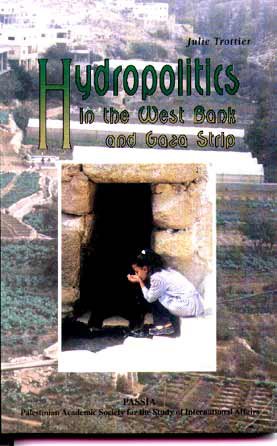Hydropolitics in the West Bank and Gaza Strip
The issue of water is one of the five issues that remain to be negotiated as part of the final status talks. This comprehensive work examines the vital resource of water as a political issue in the West Bank and Gaza Strip. The first chapter provides a valuable review of the literature on water, from hydropolitical works that focus on political and legal water issues, to technical analyses of problems such as pollution and infrastructure, to publications that propose new models and methods for water management on national and regional levels. Exploring the history of the region’s water policies in the last hundred years, the author explains the conflicts and power struggles that have occurred on the local, national, and international levels over this most important resource. The author also analyzes the current strategy of the Palestinian Water Authority. The book contains many tables, pictures, maps and an extensive bibliography, illustrating this complex issue.
Preface
Introduction and Overview of the Literature
-Overview of the Literature
-Hydropolitical Analyses
-Technical Analyses
-Models/Proposals
-Conclusion
Research Method
-General Methodology
-Methodology of this Study
Chapter 1
Historical Overview and Present Situation
Introduction
-The Colonial Borders and the Partition of the River Basin
-The Palestine Mandate and Water
-A Hydraulic Imperative since the Time of the Mandate?
-The Emergence of Israel
-The Infrastructure Works of the 1950s and the Johnston Plan
-The War of 1967
-The Occupation of Southern Lebanon
-The Expansion of Israel and Water
-The Price of Water
-The Madrid Process and Water
-The Declaration of Principles of 13 September 1993
-The Cairo Agreement of 4 May 1994
-Sharing the Water - The Taba Agreement
-The Israeli-Jordanian Peace Treaty of 26 October 1994
-The Present Situation
-Conclusion
Chapter 2
Conflicts and Conflict Analysis
Introduction:
-Dura and the Water Thief
-The Water Profit-Maker of Anabta
-The Jordanian Water Crisis of the Summer of 1998
-The Conflict Opposing the Jerusalem Water Undertaking to the Jerusalem Municipality
-The Conflict Concerning the Ein Sultan Spring
-The Competition between the American and German
-Pipelines
-Conclusion
Chapter 3
Local Hydropolitics
Introduction
-Case Studies
-The Hydropolitical Constellation of Irrigation from Wells
-The Hydropolitical Constellation of Spring Fed Irrigation
-The Hydropolitical Constellation of Water Distribution
-The Hydropolitical Constellation of Water Tankers
-Conclusion of Section 1 - Case Studies
-Discussion
-Water Control in Israel: A Modern System
-The Control of Irrigation Water: A Pre-Modern System
-The Domestic Water Control: A Nearly Modern System
-A Firm and Fragmented Social Control
-A Second Order Scarcity
-A Structurally Induced Social Scarcity
-Conclusion
Chapter 4
National Hydropolitics
-From Madrid to Cairo
-The Oslo Agreement
-The 4 May 1994 Cairo Agreement
-The Role of Water in Palestinian State Building
-A Change in Property Regime
-National Actors Interacting with Local and International Actors
-Two Contradictory Dynamics
-Parallel Sanctioned Discourses
-The Palestinian Water Authority: Between Strategy and Tactic
-Water and National Interest
-Conclusion
Chapter 5
International Hydropolitical Constellation
-Fabricating the Enemy
-The Political Constraints
-The Economic Constraints
-The Financial Constraints
-Conclusion
Bibliography
Appendices
Annex 1: Agreement between Anabta Municipality and Rameen Village Council
Annex 2: Decree No. 38
Annex 3: Palestinian Water Authority – Water Supply Verification Form -244
Annex 4: LEKA - Palestinian Water Authority Brochure -245
Annex 5: West Bank Water in Picture
Maps
Figures and Tables
Introduction:
Figure 1 - Homer-Dixon’s Model of Environmental Change and Acute Conflict
Chapter 1
Table 1 - Percentage of Water Consumption in the West Bank, 1990 -66
Table 2 - Percentage of Water Consumption According to Article 40,
Protocol Concerning Civil Affairs, Taba, 28 September 1995 66
Chapter 2
Map 1 – Area Served by the JWU … 83
Table 1 – Dura and the Water Thief …78
Table 2 – Anabta and Rameen ….80
Table 3 – Water Resources from Springs in the Jericho Area, 1998 ….86
Table 4 – Irrigated Surface in the Jericho Area, 1998 …86
Table 5 – Conflict Opposing Irrigation and Domestic Use in Jericho …94
Chapter 3
Table 1 – Average Cost of Water, 1990 100e permits have been grantedpriat
Table 2 – Summarizing the Case Studies
Table 3 – Wells and Quotas .. 107e permits have been grantedpriat
Table 4 – Wells and Shareholders . 108e permits have been grantedpriat
Table 5 – Crop Irrigation ….. 110e permits have been grantedpriat
Table 6 – Summary of Hydropolitical Constellations . 124e permits have been grantedpriat
Figure 1 – Battir …113e permits have been grantedpriat
Figure 2 133e permits have been grantedpriat
Figure 3 134e permits have been grantedpriat
Chapter 4
Table 1 – The Four Types of Property Regimes …epermits have been grantedpriat152
Figure 1 – Structure of the Legislative Power 145e permits have been grantedpriat
Figure 2 – Systemic Diagram of Various Spatial Levels and of their Embedment
Figure 3 – Two-Level Institution-Building Model 158e permits have been grantedpriat
Figure 4 – The Centrifugal and Centripetal Dynamics ..162e permits have been grantedpriat
Chapter 5
Figure 1 – Number of Irrigated Hectares in the World since 1950 190e permits have been grantedpriat
Figure 2 – Israeli Water Consumption by Sector, 1947-1993 191

